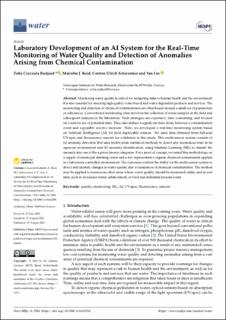| dc.contributor.author | Rudjord, Zofia Czyczula | |
| dc.contributor.author | Reid, Malcolm James | |
| dc.contributor.author | Schwermer, Carsten Ulrich | |
| dc.contributor.author | Lin, Yan | |
| dc.date.accessioned | 2022-09-21T09:21:52Z | |
| dc.date.available | 2022-09-21T09:21:52Z | |
| dc.date.created | 2022-08-22T17:18:14Z | |
| dc.date.issued | 2022 | |
| dc.identifier.citation | Water. 2022, 14 (16), 2588. | en_US |
| dc.identifier.issn | 2073-4441 | |
| dc.identifier.uri | https://hdl.handle.net/11250/3020133 | |
| dc.description.abstract | Monitoring water quality is critical for mitigating risks to human health and the environment. It is also essential for ensuring high quality water-based and water-dependent products and services. The monitoring and detection of chemical contamination are often based around a small set of parameters or substances. Conventional monitoring often involves the collection of water samples in the field and subsequent analyses in the laboratory. Such strategies are expensive, time consuming, and focused on a narrow set of potential risks. They also induce a significant time delay between a contamination event and a possible reactive measure. Here, we developed a real-time monitoring system based on Artificial Intelligence (AI) for field deployable sensors. We used data obtained from full-scan UV-spec and fluorescence sensors for validation in this study. This multi-sensor system consists of (a) anomaly detection that uses multivariate statistical methods to detect any anomalous state in an aqueous environment and (b) anomaly identification, using Machine Learning (ML) to classify the anomaly into one of the a priori known categories. For a proof of concept, we tested this methodology on a supply of municipal drinking water and a few representative organic chemical contaminants applied in a laboratory-controlled environment. The outcomes confirm the ability for the multi-sensor system to detect and identify changes in water quality due to incidences of chemical contamination. The method may be applied to numerous other areas where water quality should be measured online and in real time, such as in surface-water, urban runoff, or food and industrial process water. | en_US |
| dc.language.iso | eng | en_US |
| dc.publisher | MDPI | en_US |
| dc.rights | Navngivelse 4.0 Internasjonal | * |
| dc.rights.uri | http://creativecommons.org/licenses/by/4.0/deed.no | * |
| dc.title | Laboratory Development of an AI System for the Real-Time Monitoring of Water Quality and Detection of Anomalies Arising from Chemical Contamination | en_US |
| dc.type | Peer reviewed | en_US |
| dc.type | Journal article | en_US |
| dc.description.version | publishedVersion | en_US |
| dc.rights.holder | © 2022 by the authors. | en_US |
| dc.source.pagenumber | 11 | en_US |
| dc.source.volume | 14 | en_US |
| dc.source.journal | Water | en_US |
| dc.source.issue | 16 | en_US |
| dc.identifier.doi | https://doi.org/10.3390/w14162588 | |
| dc.identifier.cristin | 2045098 | |
| dc.source.articlenumber | 2588 | en_US |
| cristin.ispublished | true | |
| cristin.fulltext | original | |
| cristin.qualitycode | 1 | |

